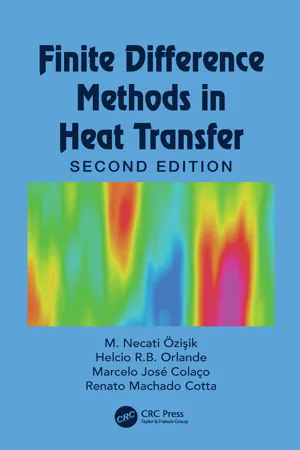
eBook - ePub
Finite Difference Methods in Heat Transfer
M. Necati Özişik, Helcio R. B. Orlande, Marcelo J. Colaço, Renato M. Cotta
This is a test
Condividi libro
- 580 pagine
- English
- ePUB (disponibile sull'app)
- Disponibile su iOS e Android
eBook - ePub
Finite Difference Methods in Heat Transfer
M. Necati Özişik, Helcio R. B. Orlande, Marcelo J. Colaço, Renato M. Cotta
Dettagli del libro
Anteprima del libro
Indice dei contenuti
Citazioni
Informazioni sul libro
Finite Difference Methods in Heat Transfer, Second Edition focuses on finite difference methods and their application to the solution of heat transfer problems. Such methods are based on the discretization of governing equations, initial and boundary conditions, which then replace a continuous partial differential problem by a system of algebraic equations. Finite difference methods are a versatile tool for scientists and for engineers. This updated book serves university students taking graduate-level coursework in heat transfer, as well as being an important reference for researchers and engineering.
Features
- Provides a self-contained approach in finite difference methods for students and professionals
- Covers the use of finite difference methods in convective, conductive, and radiative heat transfer
- Presents numerical solution techniques to elliptic, parabolic, and hyperbolic problems
- Includes hybrid analytical–numerical approaches
Domande frequenti
Come faccio ad annullare l'abbonamento?
È semplicissimo: basta accedere alla sezione Account nelle Impostazioni e cliccare su "Annulla abbonamento". Dopo la cancellazione, l'abbonamento rimarrà attivo per il periodo rimanente già pagato. Per maggiori informazioni, clicca qui
È possibile scaricare libri? Se sì, come?
Al momento è possibile scaricare tramite l'app tutti i nostri libri ePub mobile-friendly. Anche la maggior parte dei nostri PDF è scaricabile e stiamo lavorando per rendere disponibile quanto prima il download di tutti gli altri file. Per maggiori informazioni, clicca qui
Che differenza c'è tra i piani?
Entrambi i piani ti danno accesso illimitato alla libreria e a tutte le funzionalità di Perlego. Le uniche differenze sono il prezzo e il periodo di abbonamento: con il piano annuale risparmierai circa il 30% rispetto a 12 rate con quello mensile.
Cos'è Perlego?
Perlego è un servizio di abbonamento a testi accademici, che ti permette di accedere a un'intera libreria online a un prezzo inferiore rispetto a quello che pagheresti per acquistare un singolo libro al mese. Con oltre 1 milione di testi suddivisi in più di 1.000 categorie, troverai sicuramente ciò che fa per te! Per maggiori informazioni, clicca qui.
Perlego supporta la sintesi vocale?
Cerca l'icona Sintesi vocale nel prossimo libro che leggerai per verificare se è possibile riprodurre l'audio. Questo strumento permette di leggere il testo a voce alta, evidenziandolo man mano che la lettura procede. Puoi aumentare o diminuire la velocità della sintesi vocale, oppure sospendere la riproduzione. Per maggiori informazioni, clicca qui.
Finite Difference Methods in Heat Transfer è disponibile online in formato PDF/ePub?
Sì, puoi accedere a Finite Difference Methods in Heat Transfer di M. Necati Özişik, Helcio R. B. Orlande, Marcelo J. Colaço, Renato M. Cotta in formato PDF e/o ePub, così come ad altri libri molto apprezzati nelle sezioni relative a Sciences physiques e Énergie. Scopri oltre 1 milione di libri disponibili nel nostro catalogo.
Informazioni
1
Basic Relations
Numerical methods are useful for solving fluid dynamics, heat and mass transfer problems, and other partial differential equations of mathematical physics when such problems cannot be handled by exact analysis techniques because of nonlinearities, complex geometries, and complicated boundary conditions. The development of high-speed digital computers significantly enhanced the use of numerical methods in various branches of science and engineering. Many complicated problems can now be solved at a very little cost and in a very short time with the available computing power.
Presently, the finite difference method (FDM), the finite volume method (FVM), and the finite-element method (FEM) are widely used for the solution of partial differential equations of heat, mass, and momentum transfer. Extensive amounts of literature exist on the application of these methods for the solution of such problems. Each method has its advantages depending on the nature of the physical problem to be solved, but there is no best method for all problems. For instance, the dimension of the problem is an important factor that deserves some consideration because an efficient method for one-dimensional problems may not be so efficient for two- or three-dimensional problems. FDMs are simple to formulate and can readily be extended to two- or three-dimensional problems. Furthermore, FDM is very easy to learn and apply for the solution of partial differential equations encountered in the modeling of engineering problems for simple geometries. For problems involving irregular geometries in the solution domain, the FEM is known for having more flexibility because the region near the boundary can readily be divided into subregions. A major drawback of FDM used to be its difficulty to handle effectively the solution of problems over arbitrarily-shaped complex geometries because of interpolation between the boundaries and the interior points, in order to develop finite difference expressions for nodes next to the boundaries. More recently, with the advent of numerical grid generation approaches, the FDM has become comparable to FEM in dealing with irregular geometries, while still maintaining the simplicity of the standard FDM.
In this book, we ...